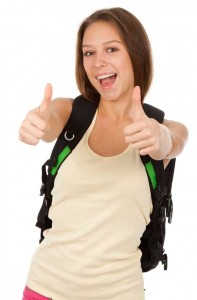 Think the books and school supplies that your child is carrying in a backpack slung haphazardly across one shoulder are harmless? Think again!
Think the books and school supplies that your child is carrying in a backpack slung haphazardly across one shoulder are harmless? Think again!
Heavy loads carried by millions of students across the U.S. can cause low back pain that often lasts through adulthood. According to the U.S. Consumer Product Safety Commission, in 2010 nearly 28,000 strains, sprains, dislocations, and fractures from backpacks were treated in hospital emergency rooms, physicians’ offices, and clinics. “A child wearing a backpack incorrectly or that is too heavy can be contributing risk factors for discomfort, fatigue, muscle soreness, and musculoskeletal pain especially in the lower back,” says Karen Jacobs, EdD, OTR/L, CPE, clinical professor of occupational therapy at Boston University, and an expert on school ergonomics and healthy growth and development of school-age children.
Backpack Facts
Due to the growing numbers of children who sustain backpack related injuries, the American Occupational Therapy Association (AOTA) has designated every third Wednesday of September as National School Backpack Awareness Day-a day to educate parents, teachers, educators and kids about the serious health effects resulting from backpacks that are too heavy or improperly worn. Consider these facts:
- More than 79 million students in the United States carry school backpacks.
- More than 2,000 backpack-related injuries were treated at hospital emergency rooms, doctor’s offices, and clinics in 2007.
- About 55% of students carry a backpack that is heavier than the recommended guideline of 10% of the student’s total body weight.
- In one study of American students ages 11 to 15 years, 64% reported back pain related to heavy backpacks. Twenty one percent reported the pain lasting more than six months.
- In a study on the effect of backpack education on student behavior and health, nearly eight out of ten middle school students who changed how they loaded and wore their backpacks reported less pain and strain in their backs, necks, and shoulders.
- According to a study by Boston University, approximately 85% of university students self-report a discomfort and pain associated with backpack usage.
 Tips for Keeping Your Kids Safe
Tips for Keeping Your Kids Safe
The way backpacks are worn affects your child’s health. Here are some tips to help your child avoid backpack related health issues and injuries:
Always select a backpack that is the correct size for your child. Make sure the height of the backpack extends from approximately 2 inches below the shoulder blades to waist level, or slightly above the waist. Shoulder straps should be well padded.
- Distribute weight evenly. Load heaviest items closest to the child’s back and balance materials so the child can easily stand up straight.
- The backpack should always be worn on both shoulders so the weight is evenly distributed
- If there is one, the hip belt should be worn to improve balance and take some strain off sensitive neck and shoulder muscles.
- Once packed, the backpack should weigh no more than 10% of your child’s body weight. If it weighs more, determine what supplies can stay at home or at school each day to lessen the load. If the backpack is still too heavy for the child, consider a book bag on wheels.
About the AOTA
Founded in 1917, the American Occupational Therapy Association (AOTA) represents the professional interests and concerns of more than 140,000 occupational therapists, assistants, and students nationwide. The Association educates the public and advances the profession of occupational therapy by providing resources, setting standards including accreditations, and serving as an advocate to improve health care. Based in Bethesda, Md., AOTA’s major programs and activities are directed toward promoting the professional development of its members and assuring consumer access to quality services so patients can maximize their individual potential. For more information, go to www.aota.org.
Your Partner In Health,
Graybill Medical Group
